Two Vellum Leaves from a Large-Format Latin Breviary in Gothic Script
October 2, 2021 in Manuscript Studies
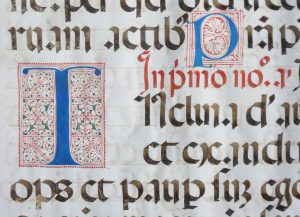
Private Collection, MS 1, Fol. 1 (‘137’)r, Initial I (for Inclina). Photography Mildred Budny. Reproduced by permission.
A Pair of Non-Consecutive Leaves
from a Large-Format
Latin Breviary
in Gothic Script on Vellum
Circa 590 mm × 447 mm
< written area circa 397 × 307 mm>
Single column of 15 lines
in Gothic Script
with rubrications, embellished initials,
and reiterated medieval and modern ‘folio’ numbers
Folio 1 (‘130’)
Vulgate Psalms (Septuagint Translation) 83:11 – 84:12 (Veri-[tas])
and
Folio 2 (‘137’)
Within Friday Matins:
Hymn Tu Trinitatis Unitas ([ . . . Ne corpus /] assit sordidum . . . Pater piissime)
Antiphon Inclina Domine, and Psalm 86 1:1–12 (Con-[fitebor])
14th or 15th Century, perhaps Italian or Spanish
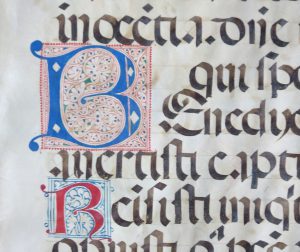
Private Collection, MS 1, Fol. 130r, initials B and R. Photography Mildred Budny. Reproduced by permission.
Continuing to examine manuscripts and fragments in our blog on Manuscript Studies (see its Contents List), we turn to a pair of large, single leaves which arrived in a Private Collection several years ago, as a gift from another Private Collection. About this pair of leaves, we might exclaim: What beauties!
For the current owner, with an interest in manuscript studies, especially medieval manuscripts, these leaves comprise the first in the library (mostly printed books about books). Hence the assigned number, “MS 1”, with two detached leaves (Folios ‘1’ and ‘2’ in the set) from the same original manuscript.
The identity and origin of that manuscript remain, for now, unknown. Perhaps this blogpost, presenting the detached leaves to wider view through their photographs and related information, might bring to light more information about them and their travels across time and place.
The pair came on their own, safely packaged with mats in a large shipping box, but without any accompanying information. That is, apart from the former owner’s recollection relayed in conversation and email.
These two large leaves would have come as a purchase some years ago, in the late 1980s or early 1990s, at the New York Antiquarian Book Fair, a repeated venue for some other purchases for the same collection.
“The two large ones are German and quite late, if I remember rightly. I bought them from a German dealer at the NY Antiquarian Book Fair. No, I don’t recall his name. It was a looong [sic] time ago. I suspect the two smaller ones [= MS 2, in another shipping] were purchased at the same venue, though different dealer.”
On their own, the two leaves must or can speak for itself. We bring to the table the willingness to examine them closely, to admire their resonant beauty, and to see what they can say. Their story resides not only in the text, which can be deciphered, abbreviations and all, but also in the features of layout, script, decoration, rubrications, annotations, the animal skins for the writing surfaces, the traces of a former binding, and other forms of material evidence.
[Update: In a Comment below, Joanne Overty (see Joanne Filippone Overty) observed that the pair “Looks like two leaves from a Northern Italian choir book (probably from the psalter). Mid 15th c[entury].” We thank her for her contribution to knowledge about these materials.]
Leaves 1 and 2 (or ‘130’ and ‘137’ according to numbers on their pages)

Private Collection, MS 1, Fol. 137r with guide. Photography Mildred Budny. Reproduced by permission.
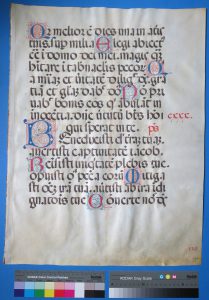
Private Collection, MS 1, Fol. 130r with guide. Photography Mildred Budny. Reproduced by permission.
Made on vellum (probably calf- or cow-skin), the leaves originally belonged to a single large-format manuscript bearing liturgical texts in stately, upright Gothic script, with rounded features. Enlarged and expertly embellished initials in blue and red pigment open sections (or verses) of the text. Those sections run together, as paragraphs.
The text is Latin, laid out in single columns of 15 lines on the page. The written area of the column measures circa 397 × 307 mm, defined by a ladder-like grid of narrow parallel horizontal lines drawn in black ink.
The main text is written in formal Gothic script with rounded features. The bodies of the letters — the ‘lower-case’ minims (i, n, m, u) and such letters as a standard a, c, e, etc. — stand between those horizontal hair-line rulings, which provide the grid to guide the script within the column and within the lines. This positioning conforms with a known shift in scribal practice which took place principally in the second quarter of the thirteenth century (to judge by surviving manuscripts), from “above top line to below top line” for writing the first line of text on a page within the ruled framework. This shift was memorably observed and described by N. R. Ker (“From ‘Above Top Line’ to ‘Below Top Line’ “ and ditto).
The openings of individual sections or verses are highlighted by enlarged initials, painted and “built-up” mostly in red or blue pigment in a rhythmically alternating sequence. They are provided with pen-line embellishment in the contrasting color, such that blue initial has red embellishment, and vice versa. One initial (the B on Folio 130r) also has elements in green pigment filling parts of the background, within both the initial and the right-hand side of the frame.
The ornamental scheme is simple, yet effective, without reaching higher realms with costlier pigments. Perhaps such levels were afforded by major openings of the text, or the volume itself.
Inset within the text, the initials stand embedded in outlined rectangular frames which contain fillings of geometric and foliate ornament rendered expertly in pen-lines. Their effect resembles delicate filigree ornament. The pen-line frames and fillings are made in the contrasting color, to amplify the alternation, applying decoration in blue pen-lines to enclose the red initials, and red pen-lines to enclose the blue initials.
With their frames, the ‘lesser’ initials, opening sections or verses, usually extend the full height of the ruled line and the interlines above and below it. Some initials encroach upon the lines of text in ink. The overlap of the ink letters over the colored pigments shows that the bichrome embellishment preceded the writing of the lines of text.
Two major initials open passages of text, in each case individual Psalms. They appear midway down each recto at the right-hand side: B (for Benedixisti) on Leaf 1, and I (for Inclina) on Leaf 2.
The initials stand within the areas inset for them within the lines of text. The B stands 2-lines high; the I stands 3-lines high. Both are blue, with red ornament. Whereas the bodies of all other painted initials are solid, the B has four inset patterns of diamond-shaped motifs left ‘in reserve’, or unpainted. They stand at top and bottom of the stem of the letter, and at the outer curve of each of its bows.
One side of each leaf carries a ‘duplicate’ or reiterated set of arabic numbers in the lower outer corner, either 130 or 137. That side is the hair side of the animal skin on one leaf (Folio ‘1’ or 130), whereas the hair side is turned to the verso on the other leaf (Foli0 ‘2’ or 137).
The side with those numbers must be the recto of the leaf, as confirmed also by the stitching line of the inner margin, which stands at the inside of the leaf — that is, the left-hand side as we face that side, or page.
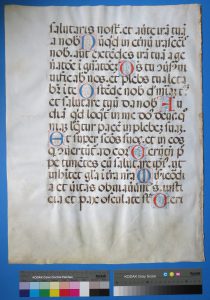
Private Collection, MS 1, Fol. 130v. Photography Mildred Budny. Reproduced by permission.

Private Collection, MS 1, Fol. 137v. Photography Mildred Budny. Reproduced by permission.
Turning the leaf over, to view the next page (the verso), we can observe the unbroken continuation of the text from the recto, in the same layout, script, and style of decoration. In addition, there are faint, or discreet, entries in pencil in the lower margin.
That the recto of each leaf in each case carries a more prominent decorated initial may have directed the decision to place the modern pencil entries on the verso. At the bottom of each verso there appear two entries, spaced at left and right.
A seller’s code in a long string of letters (upper and lower case) and arabic numerals stands at the left. The price in US dollars stands at the right. For one leaf, the price was “$135.00”, and for the other “$155.00”.
Folio 130: 5896nn4C13h5/45ST $135—
Folio 137: 5896qq4C13h5/45ST $155—
Entered by the same hand apparently at a single time, presumably after the leaves had been removed from their book, these entries evidently pertain to a single stage in the history of the manuscript. The style of coding might be familiar to others acquainted with specific sellers of manuscript or other fragments in North American markets in the past half-century or so. If so, the authorship and the meaning of the different elements in the code might be revealed more clearly. Does, for example, the element C13 here designate a 13th-century date or conjecture?
The seller’s codes might lead to information about when (and whence?) the leaves entered the inventory, and, by extension or inference, when that stock was sold, where, and to whom. As yet, those identities remain unknown. Might you have further information?
We examine the leaves one by one.
I. Folio 1 (‘130’)
The Recto
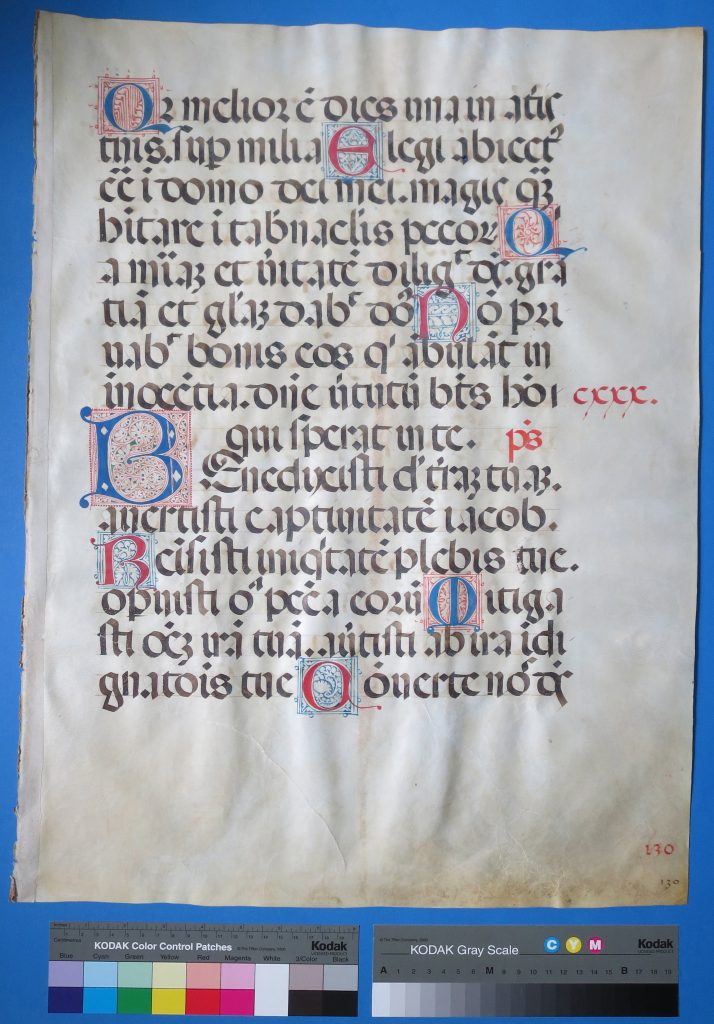
Private Collection, MS 1, Fol. 130r with guide. Photography Mildred Budny. Reproduced by permission.
We might see at a glance that this side is the recto of the leaf because its column of script stands between the inner margin (edged by the former gutter and its line of stitching) and the broader outer margin, which probably remains untrimmed in its original state. The outer margin carries several marks of orientation regarding both the sequence of the text and the position of the leaf within the sequence of leaves in the former volume. That the volume was bound is established by the stitching marks and stains along the fold of the former gutter.
On the recto some marks appear in red pigment. In the outer margin opposite line 8 of the text stands the roman numeral cxxx. Indented at the end of the next line is the abbreviated heading p’s [for Psalmus], which pertains to the text beginning with the initial B in the following line.
The lower outer corner has the arabic folio number 130 likewise in red. The number is repeated to its lower right in brown ink.
The elements in red apparently pertain to the original stage(s) of production and assembly of the manuscript. The ink numbering is presumably modern or early modern. It could pertain to the work of an owner, curator, or seller examining the volume leaf-by-leaf and recording their numbers in sequence, ‘translating’ the form of the medieval number cxxx into a more familiar arabic numeral. The pair of numerals at the bottom comprise a form of dittography, offering identical twins: 130 in red and again in black.
The equivalent roman numeral cxxx in red midway in the outer margin appears to reinforce this numbering scheme. However, its location seems strange for a folio number, and the text does not belong to Psalm 130.
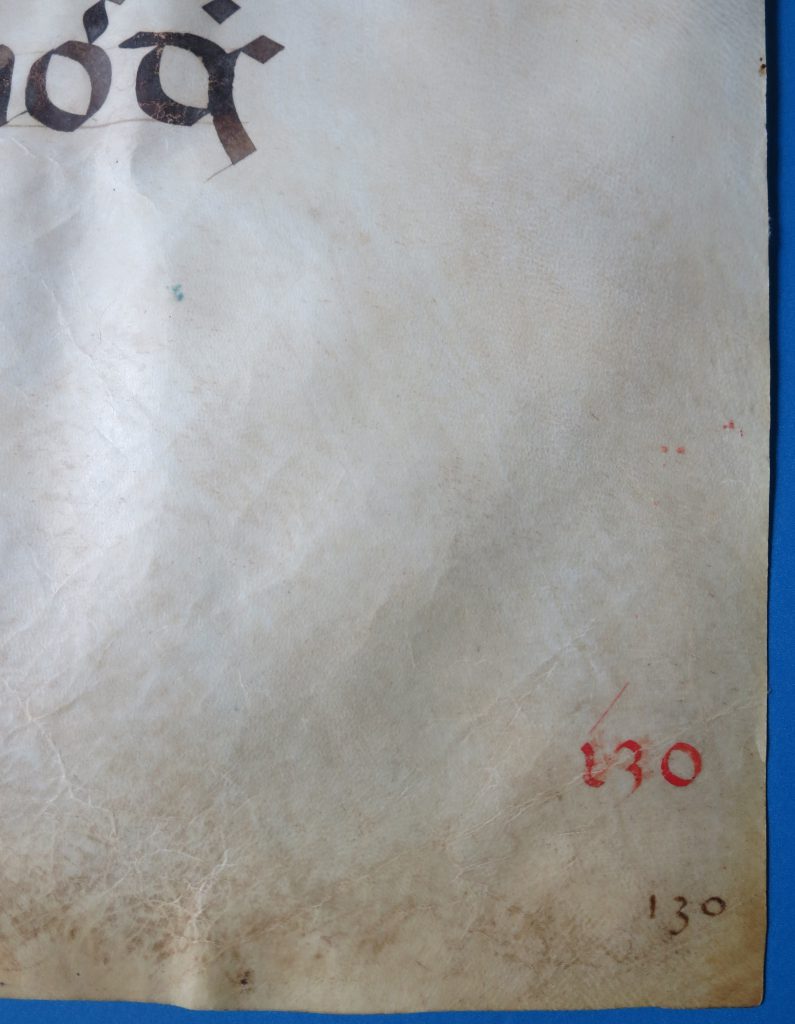
Private Collection, MS 1, Fol. 130r, lower right: Folio number in red. Photography Mildred Budny. Reproduced by permission.
The Verso
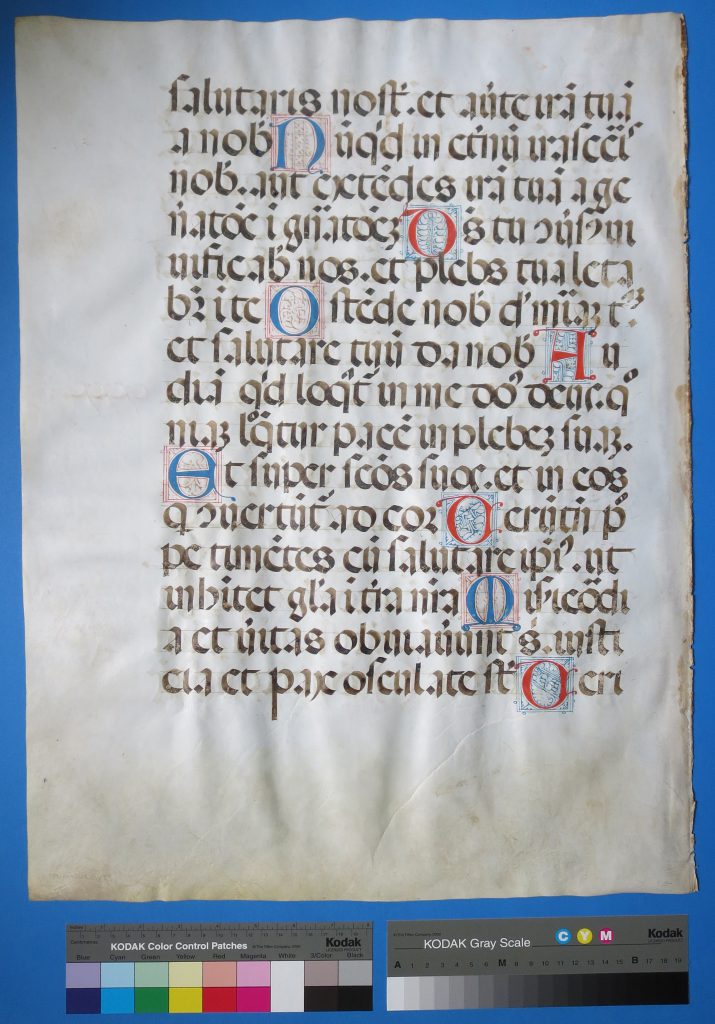
Private Collection, MS 1, Fol. 130v cropped. Photography Mildred Budny. Reproduced by permission.
The Text: Parts of Psalms 83–84
The text on the leaf begins with a verse at the top of the recto and ends mid-verse at the bottom of the verso. Between these points, the text moves from the end of one Psalm through most of the next.
First, we scrutinize the text, line by line. Having identified the text, we compare the reading on the leaf with some available online editions of the Latin versions.
Let us consider the text, as laid out line-by-line on the two pages. Reading and looking progress hand-in-hand.
First, how does the consecutive sequence of text take its place upon the leaf, recto and verso?
1. Transcription
A transcription might guide the orientation.
In the Vulgate Version of the Bible, prepared by its translator Jerome (who lived circa 342 – c. 347 until 420), the renditions of Book of Psalms take form according to the translation from the Greek Septuagint (LXX) and the translation from the Hebrew. Here the text follows the Septuagint Version.
The text on the leaf starts partway through Psalm 83. Side-by-side representations of a Latin edition and an English translation can be consulted in various sources, for example via biblehub.com or CatholicBible.online.
Such a standard can provide a convenient base-line, adding the customary verse-numbers, supplying modern punctuation, standardizing the spelling, and expanding the abbreviations in a manuscript. From such editions, it is also possible to discern what span of text should be expected both before and after the isolated leaves in ‘our’ specimen.
Here we show line-divisions conforming with the manuscript-layout, with its hairline upraised hyphens (–) indicating word-divisions at its line-endings. A forward slash (/) indicates a division between one page and another, either preceding or following. Textual elements to be expected on adjacent, but now lost or unknown, leaves are indicated within angular brackets ([ ]).
Psalm 83:11–13
Protector noster, aspice, Deus, et respice in faciem christi tui. / ]
11 Quia melior est dies una in atriis tuis
super millia; Elegi abiectus
esse in domo Dei mei magis quam
habitare in tabernaculis peccatorum. 12 Qui-
a misericordiam et veritatem diligit Deus: grat-
iam et gloriam dabit Dominus. 13 Non pri-
vabit bonis eos qui ambulant in in[-]
nocentia: Domine virtutum, beatus homo
qui sperat in te. p’s [= Psalmus]
Psalm 84
[Omitting the title or heading (In finem filius Core Psalmus), often counted as verse 1]
84:2 Benedixisti Domine terram tuam
avertisti captivitatem Iacob
2. Remisisti iniquitatem plebis tue.
operuisti omnia peccata eorum. 3. Mitiga-
sti omnem iram tuam: auertisti ab ira indi-
nacionis tue. 4. Conuerte nos deus /
Folio 130v
salutaris noster: et auerte iram tuam
a nobis. 5. Numquid in eternum irasceris
nobis: aut extendes iram tuam a ge-
neracione in generacionem. 6. Deus tu conuersus vi-
uificabis nos: et plebs tua leta-
bitur in te. 7. Ostende nobis domine misericordiam tuam:
& salutare tuum da nobis. 8. Au-
diam quid loquatur in me dominus deus: quo-
niam loquetur pacem in plebem suam. 9. Et super sanctos suos: et in eos
qui conuertuntur ad cor. 10. Uerumptamen pro-
pe timentes eum salutare ipsius: ut
inhabitet gloria in terra nostra. 11. Misericordi-
a et ueritas obuiauerunt sibi: iusti-
cia & pax osculate sunt. 12. Ueri- /
[Page break 130v / *131r]
2. The Sequence of Text on Adjacent Leaves in the Former Volume
Folio *131
The following leaf, whether or not it survives, presumably began (or begins) mid-word in this place within Psalm 84:12:
[/-tas de terra orta est: & iusticia de celo prospexit.
13. Etenim dominus dabit benignitatem: & terra nostra dabit fructum suum . . . ]
*****
II. Folio 2 (‘137’)
This leaf combines readings from more than one source text. Parts of a Psalm occupy some of the recto, fill the verso, and run over onto another (currently unknown) leaf, mid-word, ending with Con-. Other texts, or parts of texts, on the recto represent different parts, or moments, of liturgical practice within a given service.
The Recto
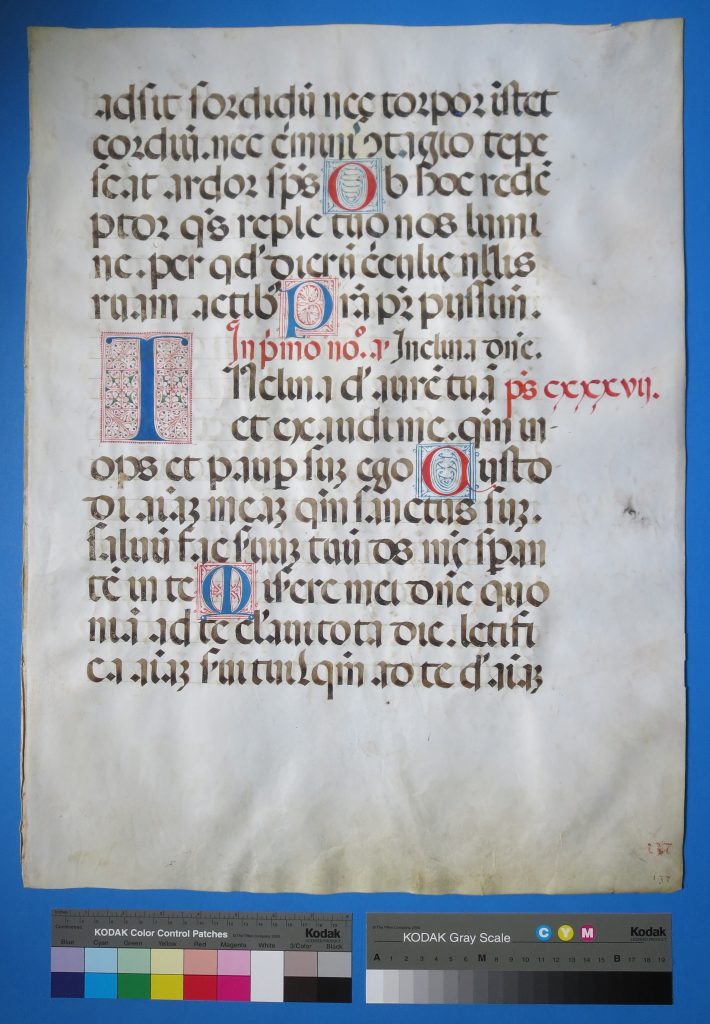
Private Collection, MS 1, Fol. 137r cropped. Photography Mildred Budny. Reproduced by permission.
The Verso
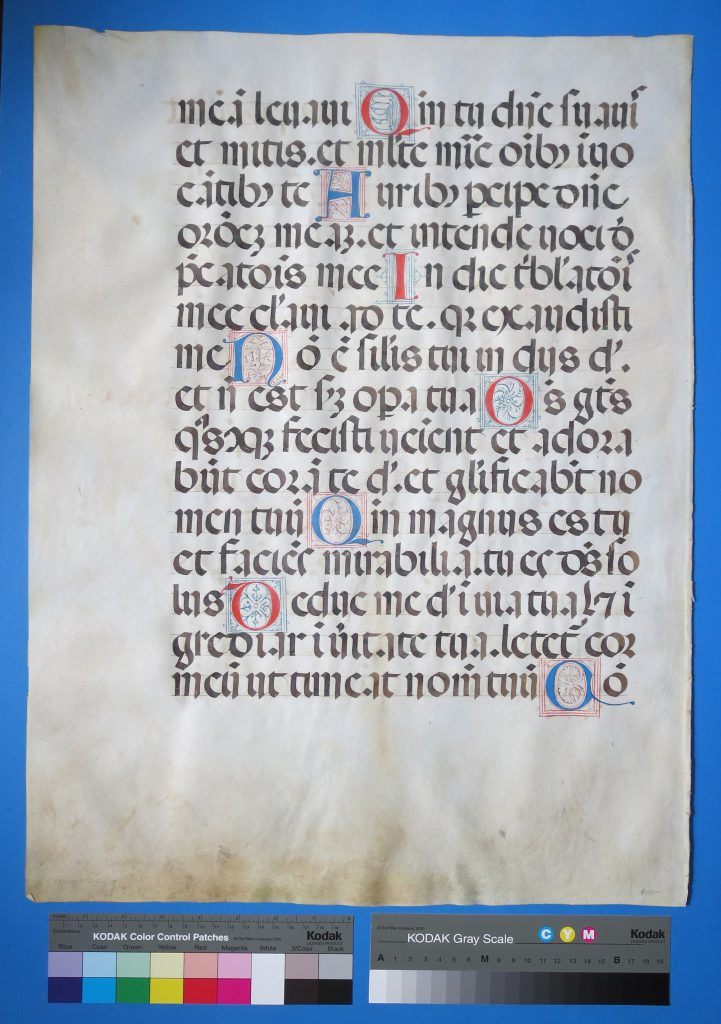
Private Collection, MS 1, Fol. 137v cropped. Photography Mildred Budny. Reproduced by permission.
The seller’s pencil annotations stand discreetly at the bottom, on the ‘lesser’ side of the leaf as might be considered with respect to monetary evaluation or the choice for display. At this scale of photographic viewing, the incompletely-scraped hair follicles of the animal skin are clearly visible.
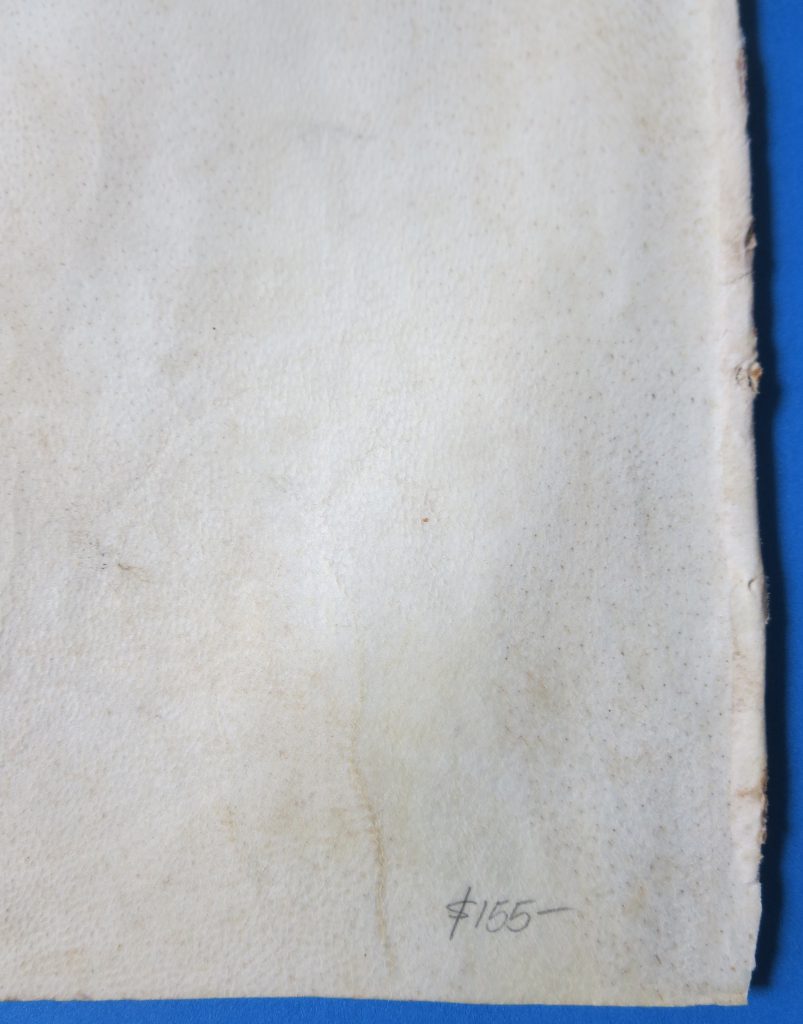
Private Collection, MS 1, Fol. 137v, bottom left.. Photography Mildred Budny. Reproduced by permission.
The Texts
1. Transcription
[Folio *136v: Opening of the Hymnus Tu Trinitatis Unitatis within Friday Matins:
Tu, Trinitatis Unitas . . .
. . . Ne corpus / ]
Folio 137r
assit sordidum, Nec torpor instet
cordium, Ne criminis contagio Tepe-
scat ardor spiritus. Ob hoc Redem-
ptor quæsumus, Reple tuo nos lumi-
ne, Per quod dierum circulis, Nullis
ruamur actibus. Præsta, Pater piissime,
In primo noctorno Antiphon Inclina Domine.
Ps 85 (86) [see the Parallel Latin/English Psalter via https://medievalist.net/psalmstxt/ps85.htm]
01. Inclina, Domine, aurem tuam
et exaudi me quoniam in-
ops et pauper sum ego 02. Custo-
di animam meam quoniam sanctus sum
salvum fac servum tuum Deus meus speran-
tem in te 03 Miserere mei Domine quo-
niam ad te clamabo tota die 04 laetif-
ica animam servi tui quoniam ad te Domine animam
[r/v]
meam levavi 05 Quoniam tu Domine suavis
et mitis et multae misericordiae ombinus invo-
cantibus te 06 Auribus percipe Domine
orationem meam et intende voci de-
precationis meae 07 In die tribulatoris
meae clamavi ad te quia exaudisti me|
8 Non est similis tui in diis Domine
et non est secundum opera tua 09 Omnes gentes
quascumque fecisti venient et adora-
bunt coram te Domine et glorificabunt no-
men tuum 10 Quoniam magnus es tu
et faciens mirabilia tu es Deus so-
lus 11 Deduc me Domine in via tua et in-
grediar in veritate tua laetetur cor
meum ut timeat nomen tuum 12 Con-
[v/r]
[/-fitebor tibi Domine Deus meus . . .]
2. The Texts
2.1. Hymn Tu Trinitatas Unitas (in part)
The text on the leaf opens partway through the Hymn beginning Tu Trinitas Unitas (“O Thou! who dost all nature sway”). This partial copy, or witness, extends from adsit sordidum nec torpor to Presta, Pater piissimi (Folio 137r, lines 1–6). The specific form of the Hymn corresponds to the one cited as “Pope Urban VIII‘s 1632 reform of the Breviary“, albeit with slight spelling variants. It also occurs in the Sarum Breviary. Among “The Hymns of the Psalter” (see also, for example, Hymns for Psalms, this one is listed for the canonical Hour of “Friday at Matins” in “The Hymns of the Breviary and Missal“.
For example, as summarized in an examination (Tu Trinitas Unitas) of the iterations of this Hymn during the liturgical year and according to different Latin rites or specifications for public worship:
This hymn is used for Matins on Fridays throughout the year in the Extraordinary Form in the Roman Breviary. In the Ordinary Form, this hymn is used for the hymn for Office of Readings on Fridays of Weeks I & III of Ordinary Time. It is also used for Lauds on Trinity Sunday. In the Sarum Breviary, it was used for Matins on Fridays throughout the year. In the Mozarabic Breviary, it is listed as a hymn for Nocturns (Matins?) on Thursday in the old Hymnarium.
2.2. Antiphon Inclina Domine
Line 7, standing offset to the left as part of the 3-line indentation for the initial I of the next line, presents the rubricated heading In primo noctorno Antiphon and the opening words in ink, Inclina domine, which serve as its cue.
This antiphon, a short chant sung as a refrain, is recorded, with its musical notation, more fully in many medieval manuscripts and early modern books, as listed, for example, in the Cantus Database for Latin Ecclesiastical Chant . The antiphon is Cantus Index 00361. For its recorded specimens, see the list for Inclina domine.
The phrase ‘Presta Pater Piissimie’ is the first line of the verse, which ‘our’ manuscript omits or elides:
Præsta, Pater piissime,
Patrique compar Unice,
Cum Spiritu Paraclito,
Regnans per omne sæculum. Amen.
The verse is used as a chant on its own (https://cantus.uwaterloo.ca/chant/637805 ). For example, it figures as the last verse of ‘Te lucis ante terminum’, among others.
2.3. Psalm 85 (86) (in part)
There follows the first part of Psalm 85 (86), again according to the Septaugint Version. It begins with the same phrase as the preceding Antiphon, Inclina domine aurem tuam . . .
Carrying over from recto to and through the verso, the text of the Psalm extends to verse 12. It breaks off mid-word in its first word at the bottom of the verso: Con-[/fitebor tibi Domine Deus meus . . . ].
The Sequence of Texts
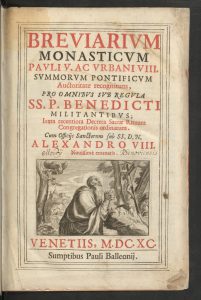
Breviarium Monasticum (Venice, 1690), Title Page, via https://doi.org/10.3931/e-rara-25941 (Public Domain).
Some or most of these texts reappear in many versions, or iterations, of Breviaries both in manuscript and printed editions.
A precise match in terms of the sequence — albeit without mention of elements for specific occasions, such as the Allel Antiphon for Temp. Pasch. following the Antiphon Inclina Domine — appears, in the earliest attestation which we have found. Moreover, it shows the same (frequently attested) variant reading of deprecationes (for orationes) in Psalm 85:6.
This match is the 1690 Monastic Breviary for Benedictine Use, printed in Venice in quarto format (Breviarium monasticum) and available in a digital facsimile .
Breviarium monasticum : Pauli V. ac Urbani VIII. auctoritate recognitum pro omnibus sub regula SS. P. Benedicti militantibus … : cum officiis Sanctorum sub SS. D. N. Alexandro […]. Venetiis : sumptibus Pauli Balleonii, 1690
(Zentralbibliothek Zürich, Ro 133, via https://doi.org/10.3931/e-rara-25941 / Public Domain Mark.)
The portions of text on the manuscript leaves correspond to pages 63 and 65–66 (images 63 and 65–66 in the facsimile) within the section for the Psalterium dispositum per hebdomadam secundum regulam sanctissimi P[atri]. Benedicti Cum Ordinario Officii de Tempore (“The Psalter arranged for daily use according to the Rule of the Most Holy Father Benedict, with the Ordinary of the Office according to the Season”). In the printed book, that section spans pages 1–113 ( images 42–155).
The frontispiece and opening page for that section set the scene. A framed image of the enthroned and inspired Psalmist, with crown and harp, faces the text in double columns with rubricated headings.
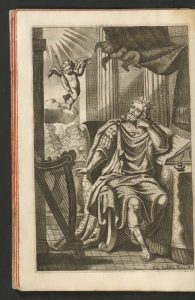
Breviarium Monasticum (Venice, 1690), Psalmist Frontispiece (image 42) facing Page 1, via https://doi.org/10.3931/e-rara-25941 (Public Domain).
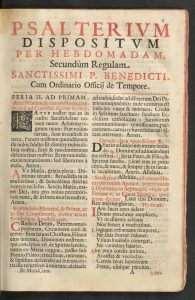
Breviarium Monasticum (Venice, 1690), Page 1 (image 43), via https://doi.org/10.3931/e-rara-25941 (Public Domain).
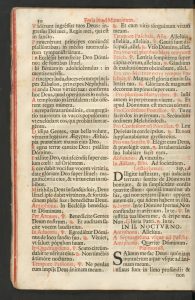
Breviarium Monasticum (Venice, 1690), Page 50 (image 92, opening Feria V ad Matutinum, via https://doi.org/10.3931/e-rara-25941 (Public Domain).
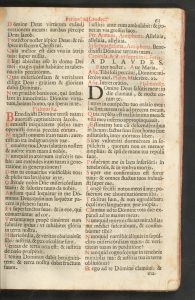
Breviarium Monasticum (Venice, 1690), Page 63 (image 105), via https://doi.org/10.3931/e-rara-25941 (Public Domain).
Breviarium Monasticum, Pages 62–63
Feria v. ad Matutinum
. . . Psalmus 83.
Qvam dilecta tabernacula tua . . .
qui sperat in te.
Psalmus 84,
Benedixisti Domine terram tuam . . .
& ponet in via gressus suos.
Pages 65–66
FERIA SEXTA.
Ad Matutinum . . .
Hymnus. Tv Trinitatis unitas . . .
Præsta, Pater piissime . . .
IN PRIMO NOCTORNO.
Antiphona. Inclina Domine.
Temp.Pasch.Antiphona. Allel. Psal.85.
Inclina Domine aurem tuam . . .
So far, a close look at the texts on the leaves indicates that they belonged almost certainly to a monastic breviary according to Benedictine Use.
More research might show, for example, which community or location for which the former manuscript was intended, or for which it served. The absence of marks of use on the pair of leaves — apart from signs of wear and stains and remnants along the gutter from the spine of a former leather-covered binding – might indicate limited, or careful, use.
The Place of the Leaves in their Book
The number 130 on Folio 1/’130′ could be feasible as a folio number for a Psalter, if that were the only text in the original manuscript. Had we access only to this leaf, carrying only text from Psalms, we might believe that the manuscript was such a case.
First, we consider the span of such a text in a volume, or portion, of its own. The Clementine Text Project for the Vulgate lists the following 14 lines which —almost — exactly cover the leaf.
Disregarding its 84:1 (a form of title or heading for the Psalm), there are 13 lines here. Verse 83:11 is on line 1388 of the text. Assuming the same rate of script throughout, about 1388/13 leaves would precede this one = 107 leaves. So this would be folio 108. That assumes that the first leaf started with the Beatus Vir of Psalm 1:1. A table of contents, or any other prefatory text, might account for the other 22 leaves.
That evaluation would be consistent with the pair of modern ‘130’ numbers (red pigment and black ink) at the foot of the recto.
However, the other known leaf from the same manuscript, preserved in the same Private Collection, carries other liturgical Latin texts as well as portions from the Book of Psalms in the Vulgate Version. The rubrication midway down the outer margin carries a comparably large number, but this time paired with the abbreviation for Psalms: ps. cxxxvii, or ‘137’.
The same number, ‘translated’ from those roman numerals afresh into arabic numerals (and absent the label for Psalms), appears in the lower outer corner of the page, as 137 written both in red pigment (medieval) and, below, in black ink (modern).
At first glance (and more than first), they appear as folio numbers — rather than page numbers, because no comparable numbers appear on the versos. But the mid-page rubrications do not conform with the conventional numbering for Psalms.
It remains uncertain what force or weight is carried, or intended, by those numbers, both cxxx and cxxxvii, and 130 and 137. Might you know?
The Decorated Initials and the Rubrication
Largest on the first leaf is the initial B of Benedixisti (Psalm 84:2).
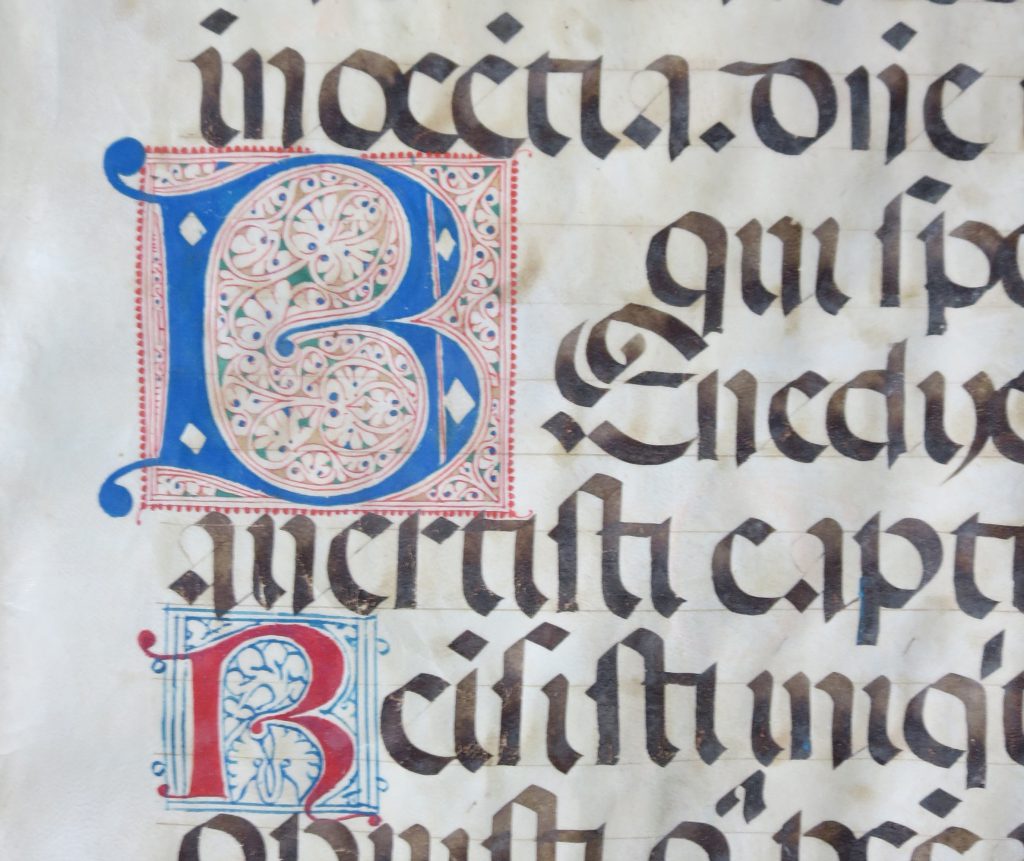
Private Collection, MS 1, Fol. 130r, initials B and R. Photography Mildred Budny. Reproduced by permission.
This initial, alone among the embellished initials on both leaves, adds elements of green pigment to the ‘standard’ or ‘customary’ alternation of red and blue pigments for enhanced section initials. That standard for the variation is represented, or set, by the initial which stands inset two lines below, for the next verse: R for Remisisti.
Note that the initials and their decorated elements in pigment were placed upon the page before the writing of the script in black ink. The letters in ink overlie, and partly obscure, the decorated initials and their frame-like settings created by lines of penwork.
Other initials claim attention similarly for their attention to detail and design. For example, on the verso of the same leaf:
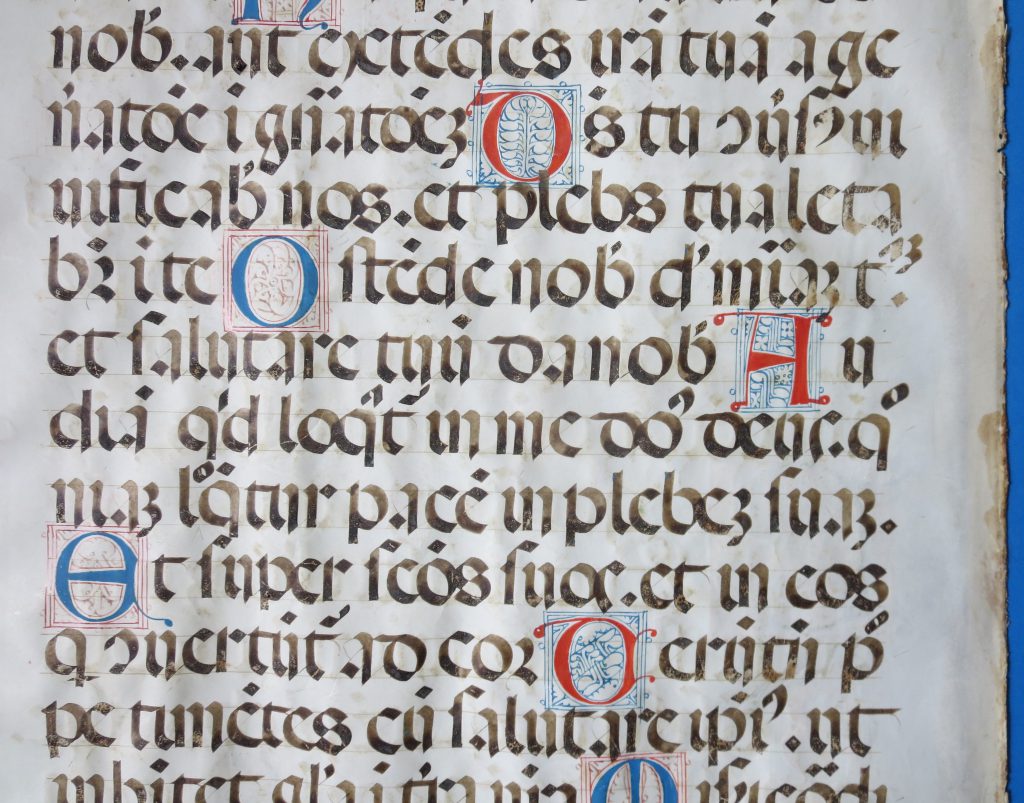
Private Collection, MS 1, Fol. 130v, mid-section. Photography Mildred Budny. Reproduced by permission.
On the recto of the same leaf:
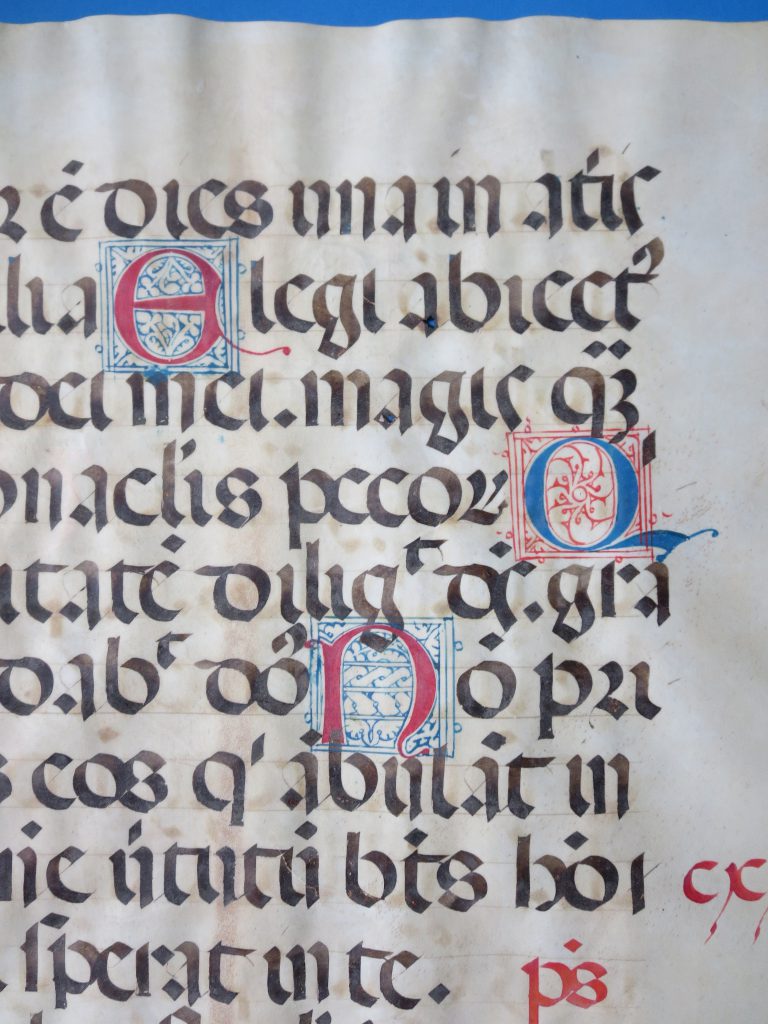
Private Collection, MS 1, Fol. 130r top right. Photography Mildred Budny. Reproduced by permission.
In each case, the initial itself, and/or its decoration extends beyond the frame allocated to the initial, somewhat or more.
*****
The Original Manuscript and the Possible Date and Place of Origin
The elements of script and decoration on this detached leaf suggest an Italian, or Spanish, origin. (According to oral tradition, conveyed by the previous owner, the dealer in the 1980s or 1990s said that it was “German”.) The round, rotund script probably points to the fourteenth or fifteenth century. The highly abbreviated text is laid out in paragraphs rather than verse form, which might allow for a greater rate of text-per-leaf and text-per-page in the stately, upright script in a large-format book evidently designed for public liturgical performance.
Further research might reveal the survival and distribution of other leaves from the manuscript. Given the size, they might not be hard to spot — that is, if they survive as full leaves or sets of leaves. The duplicate ‘folio’ numbers in red and black appear to offer instantly recognizable characteristics — that is, if they occur on other leaves.
The distinctive penwork and its combination of decorative motifs — interlace, foliate motifs, and linear ornament — in the initials set within outlined rectangular frames might appear on other leaves, or some of them, as the work of a given scribal artist.
*****
Do you know of other leaves from this manuscript? Other works by the same scribe(s)? Do you have suggestions about the probable date and place of origin?
Please leave your Comments below, Contact Us., or visit our Research Group Facebook Page.
Please let us know.
More discoveries on the way. Please watch this space.
*****

What ate the dimensions of the leaf?
Thank you for your question. We checked, and added the dimensions to the post.
Looks like two leaves from a Northern Italian choir book (probably from the psalter). Mid 15th c.
Thank you for your comment, Joanne Overty. We are glad to learn more.